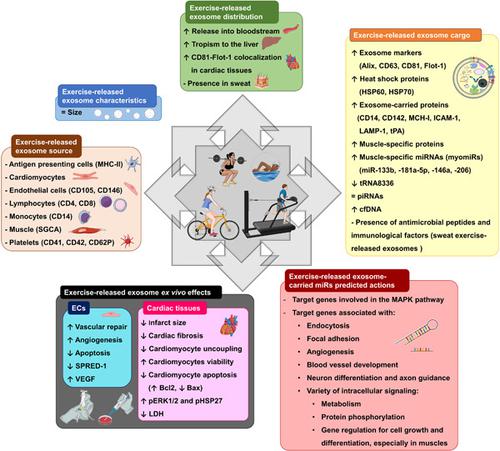当前位置:
X-MOL 学术
›
J. Cell. Physiol.
›
论文详情
Our official English website, www.x-mol.net, welcomes your
feedback! (Note: you will need to create a separate account there.)
Effects of exercise on exosome release and cargo in in vivo and ex vivo models: A systematic review
Journal of Cellular Physiology ( IF 4.5 ) Pub Date : 2020-10-09 , DOI: 10.1002/jcp.30094 Brisamar Estébanez 1 , David Jiménez-Pavón 2, 3 , Chun-Jung Huang 4 , María J Cuevas 1 , Javier González-Gallego 1
Journal of Cellular Physiology ( IF 4.5 ) Pub Date : 2020-10-09 , DOI: 10.1002/jcp.30094 Brisamar Estébanez 1 , David Jiménez-Pavón 2, 3 , Chun-Jung Huang 4 , María J Cuevas 1 , Javier González-Gallego 1
Affiliation

|
Exercise‐released exosomes have been identified as novel players to mediate cell‐to‐cell communication in promoting systemic beneficial effects. This review aimed to systematically investigate the effects of exercise on exosome release and cargo, as well as provide an overview of their physiological implications. Among the 436 articles obtained in the database search (WOS, Scopus, and PubMed), 19 articles were included based on eligibility criteria. Results indicate that exercise promotes the release of exosomes without modification of its vesicle size. The literature has primarily shown an exercise‐driven increase in exosome markers (Alix, CD63, CD81, and Flot‐1), along with other exosome‐carried proteins, into circulation. However, exosome isolation, characterization, and phenotyping methodology, as well as timing of sample recovery following exercise can influence the analysis and interpretation of findings. Moreover, a large number of exosome‐carried microRNAs (miRNAs), including miR‐1, miR‐133a, miR‐133b, miR‐206, and miR‐486, in response to exercise are involved in the modulation of proliferation and differentiation of skeletal muscle tissue, although antigen‐presenting cells, leukocytes, endothelial cells, and platelets are the main sources of exosome release into the circulation. Collectively, with the physiological implications as evidenced by the ex vivo trials, the release of exercise‐promoted exosomes and their cargo could provide the potential therapeutic applications via the role of intercellular communication.
中文翻译:

运动对体内和体外模型中外泌体释放和货物的影响:系统评价
运动释放的外泌体已被确定为介导细胞间通讯以促进全身有益作用的新参与者。本综述旨在系统地研究运动对外泌体释放和货物的影响,并概述其生理意义。在数据库搜索(WOS、Scopus 和 PubMed)中获得的 436 篇文章中,根据资格标准纳入了 19 篇文章。结果表明,运动促进外泌体的释放而不改变其囊泡大小。文献主要表明运动驱动的外泌体标志物(Alix、CD63、CD81 和 Flot-1)以及其他外泌体携带的蛋白质进入循环。然而,外泌体分离、表征和表型分析方法,以及运动后样品回收的时间可能会影响对结果的分析和解释。此外,大量外泌体携带的微小RNA(miRNA),包括miR-1、miR-133a、miR-133b、miR-206和miR-486,响应运动参与调节增殖和分化。骨骼肌组织中,虽然抗原呈递细胞、白细胞、内皮细胞和血小板是外泌体释放到循环中的主要来源。总的来说,通过体外试验证明的生理意义,运动促进的外泌体及其货物的释放可以通过细胞间通讯的作用提供潜在的治疗应用。大量外泌体携带的微小RNA(miRNA),包括miR-1、miR-133a、miR-133b、miR-206和miR-486,响应运动参与调节骨骼肌的增殖和分化尽管抗原呈递细胞、白细胞、内皮细胞和血小板是外泌体释放到循环中的主要来源。总的来说,通过体外试验证明的生理意义,运动促进的外泌体及其货物的释放可以通过细胞间通讯的作用提供潜在的治疗应用。大量外泌体携带的微小RNA(miRNA),包括miR-1、miR-133a、miR-133b、miR-206和miR-486,响应运动参与调节骨骼肌的增殖和分化尽管抗原呈递细胞、白细胞、内皮细胞和血小板是外泌体释放到循环中的主要来源。总的来说,通过体外试验证明的生理意义,运动促进的外泌体及其货物的释放可以通过细胞间通讯的作用提供潜在的治疗应用。内皮细胞和血小板是外泌体释放到循环中的主要来源。总的来说,通过体外试验证明的生理意义,运动促进的外泌体及其货物的释放可以通过细胞间通讯的作用提供潜在的治疗应用。内皮细胞和血小板是外泌体释放到循环中的主要来源。总的来说,通过体外试验证明的生理意义,运动促进的外泌体及其货物的释放可以通过细胞间通讯的作用提供潜在的治疗应用。
更新日期:2020-10-09
中文翻译:

运动对体内和体外模型中外泌体释放和货物的影响:系统评价
运动释放的外泌体已被确定为介导细胞间通讯以促进全身有益作用的新参与者。本综述旨在系统地研究运动对外泌体释放和货物的影响,并概述其生理意义。在数据库搜索(WOS、Scopus 和 PubMed)中获得的 436 篇文章中,根据资格标准纳入了 19 篇文章。结果表明,运动促进外泌体的释放而不改变其囊泡大小。文献主要表明运动驱动的外泌体标志物(Alix、CD63、CD81 和 Flot-1)以及其他外泌体携带的蛋白质进入循环。然而,外泌体分离、表征和表型分析方法,以及运动后样品回收的时间可能会影响对结果的分析和解释。此外,大量外泌体携带的微小RNA(miRNA),包括miR-1、miR-133a、miR-133b、miR-206和miR-486,响应运动参与调节增殖和分化。骨骼肌组织中,虽然抗原呈递细胞、白细胞、内皮细胞和血小板是外泌体释放到循环中的主要来源。总的来说,通过体外试验证明的生理意义,运动促进的外泌体及其货物的释放可以通过细胞间通讯的作用提供潜在的治疗应用。大量外泌体携带的微小RNA(miRNA),包括miR-1、miR-133a、miR-133b、miR-206和miR-486,响应运动参与调节骨骼肌的增殖和分化尽管抗原呈递细胞、白细胞、内皮细胞和血小板是外泌体释放到循环中的主要来源。总的来说,通过体外试验证明的生理意义,运动促进的外泌体及其货物的释放可以通过细胞间通讯的作用提供潜在的治疗应用。大量外泌体携带的微小RNA(miRNA),包括miR-1、miR-133a、miR-133b、miR-206和miR-486,响应运动参与调节骨骼肌的增殖和分化尽管抗原呈递细胞、白细胞、内皮细胞和血小板是外泌体释放到循环中的主要来源。总的来说,通过体外试验证明的生理意义,运动促进的外泌体及其货物的释放可以通过细胞间通讯的作用提供潜在的治疗应用。内皮细胞和血小板是外泌体释放到循环中的主要来源。总的来说,通过体外试验证明的生理意义,运动促进的外泌体及其货物的释放可以通过细胞间通讯的作用提供潜在的治疗应用。内皮细胞和血小板是外泌体释放到循环中的主要来源。总的来说,通过体外试验证明的生理意义,运动促进的外泌体及其货物的释放可以通过细胞间通讯的作用提供潜在的治疗应用。










































 京公网安备 11010802027423号
京公网安备 11010802027423号